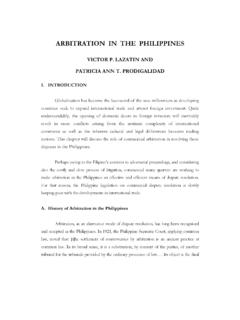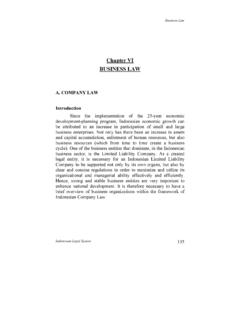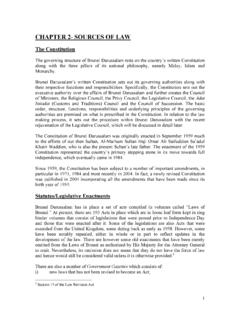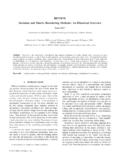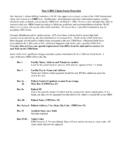Transcription of CHAPTER 1 Historical Overview - ASEAN LAW ASSOCIATION
1 CHAPTER 1. Historical Overview Introduction The Philippines, an archipelago of 7,107 islands (about 2,000 of which are inhabited), with a land area of 115,600 sq m, has a population of m. Some 87 major dialects are spoken all over the islands. English and Filipino are the official languages with English as the language of instruction in higher education. According to the 2000 census, the functional literacy rate is Agriculture constitutes the largest single sector of the economy. The country has a total labour force of The Philippine legal system is aptly described as a blend of customary usage, and Roman (civil law) and Anglo-American (common law) systems.
2 The civil law operates in areas such as family relations, property, succession, contract and criminal law while statutes and principles of common law origin are evident in such areas as constitutional law, procedure, corporation law, negotiable instruments, taxation, insurance, labour relations, banking and currency. In some Southern parts of the islands, Islamic law is observed. This particular legal system is the result of the immigration of Muslim Malays in the fourteenth century and the subsequent colonization of the islands by Spain and the United States.
3 Historical Background Philippine legal history may be categorized according to the various periods in the political history of the country: the pre-Spanish period (pre 1521); the Spanish regime (1521-1898); the Philippine Republic of 1898; the American regime (1898-1935); the Commonwealth era (1935-1946); the Japanese occupation (1941-1944); the Period of the Republic (1946-1972); the Martial Law Period (1972-1986); and the continuation of the Republic. Pre-Spanish Period Historians have shown conclusively that the early Filipinos lived in numerous independent communities called barangays under various native rules which were largely customary and unwritten.
4 Evidence points to the existence of two codes, namely, the Maragtas Code issued by Datu Sumakwel of Panay Island some time between 1200 and 1212 AD and the Penal Code of Kalantiao issued 1. by a datu of that name in 1433. however, there are some historians who question the existence of these codes. These customary laws dealt with subjects such as family relations, inheritance, divorce, usury, partnerships, loans, property rights, barter and sale, and crime and punishment. The penal law distinguished between felonies and misdemeanors, recognized a distinction between principal and accomplice in matters of criminal liability, and had an idea of the existence of qualifying and mitigating circumstances, as well as recidivism as an aggravating Like many ancient societies, trial by ordeal was practiced in the barangay.
5 The Spanish Regime The arrival of Ferdinand Magellan in the Philippines on 16 March 1521 presaged a new era in the history of Philippine law. Spanish laws and codes were extended to the Philippines either expressly by royal decrees or by implication through the issuance of special laws for the islands. The most prominent of these laws and codes were the Fuero Juzgo, Fuero Real, Las Siete Partidas, Las Leyes de Toros, Nueva Recopilacion de Las Leyes de Indias, which contained all the laws then in force in the Spanish colonies and the Novisima Recopilacion, which comprised all the laws from the fifteenth century up to At the end of Spanish rule in the Philippines, the following codes and special laws were in force in the country: the Codigo Penal de 1870 which was extended to the islands in 1887.
6 The Ley Provisional para la Aplicaciones de las Disposiciones del Codigo Penal en las Islas Filipinas in 1888; the Ley de Enjuiciamiento Criminal (Code of Criminal Procedure of 1872, which was extended in 1888); Ley de Enjuiciamiento Civil (Code of Civil Procedure of 1856);. Codigo de Comercio (Code of Commerce of 1886); Codigo Civil de 1889 (except the portion relating to marriage); the Marriage Law of 1870; the Ley Hipotecaria (Mortgage Law of 1861, which was extended in 1889); the Ley de Minas (Mining Law of 1859); the Ley Notarial de 1862; the Railway Law of 1877; the Law of Foreigners for Ultramarine Provinces of 1870; and the Code of Military The Philippine Republic of 1898.
7 By 1872, the Filipinos had revolted against Spain because of the abuses committed by the Spanish authorities and friars. The revolution spread so rapidly that on 12 June 1898, the independence of the Philippines was proclaimed by General Emilio Aguinaldo. A Revolutionary Congress was convened on 15. September 1898, and on 20 January 1899, the Malolos Constitution was 1. T Agoncillo & M Guerrero History of the Filipino People (4th edn, 1973) pp 46-7. 2. M Gamboa An Introduction to Philippine Law (7th edn, 1969) pp 69-70. 3. Ibid., p 71. 2. This Constitution proclaimed popular sovereignty and enumerated the fundamental civil and political rights of the individual.
8 At the time of its proclamation, the Republic exercised, albeit briefly, de facto authority, although this came to an end upon the coming of the Americans. The American Era and the Commonwealth The end of the Spanish-American War, which was followed by the signing of the Treaty of Paris on 10 December 1898, paved the way for the cession of the Philippines to the United States. Upon the establishment of American sovereignty, the political laws of the Philippines were totally abrogated and Spanish laws, customs and rights of property inconsistent with the US.
9 Constitution and with American principles and institutions were superseded. The government operated under different organic laws, namely, President MacKinley's Instructions to the Second Philippine Commission on 07 April 1900;. the Spooner Amendment of 1901; the Philippine Bill of 1902; the Jones Law of 1916 and the Tydings-MacDuffie Law of Pursuant to the Tydings- MacDuffie Law, a Commonwealth government was to be established for a transitional period of ten years before independence could be granted. Likewise, it granted to the Filipinos a right to formulate their own Constitution.
10 In due course, a constitution was approved on 8 February 1935 which was signed by US President Franklin D Roosevelt on 23 March 1935 and ratified at a plebiscite held on 14 May 1935, voters went to the polls to elect the first set of executive and legislative officials led by President Manuel L. Quezon and Vice-President Sergio Osme a. The Japanese Occupation On 08 December 1941, the Philippines was invaded by Japanese forces and was occupied until 1944. during the three-year military rule, a 1943 Constitution was drafted and ratified by a special national convention of the Kapisanan sa Paglilingkod ng Bagong Pilipinas (KALIBAPI),6 which led to the establishment of the short-lived Japanese-sponsored republic headed by President Jose P Laurel.
